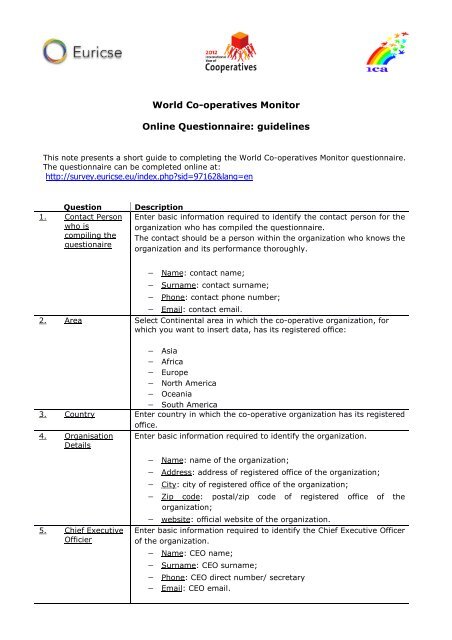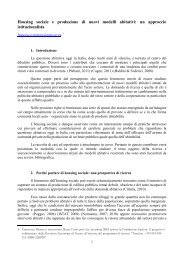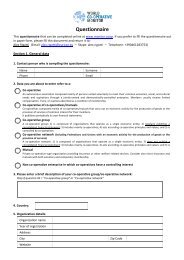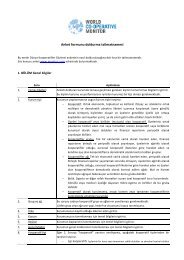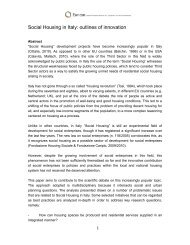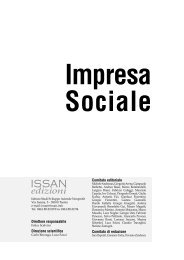World Co-operatives Monitor Online Questionnaire ... - Euricse
World Co-operatives Monitor Online Questionnaire ... - Euricse
World Co-operatives Monitor Online Questionnaire ... - Euricse
You also want an ePaper? Increase the reach of your titles
YUMPU automatically turns print PDFs into web optimized ePapers that Google loves.
<strong>World</strong> <strong>Co</strong>-<strong>operatives</strong> <strong>Monitor</strong><br />
<strong>Online</strong> <strong>Questionnaire</strong>: guidelines<br />
This note presents a short guide to completing the <strong>World</strong> <strong>Co</strong>-<strong>operatives</strong> <strong>Monitor</strong> questionnaire.<br />
The questionnaire can be completed online at:<br />
http://survey.euricse.eu/index.php?sid=97162&lang=en<br />
Question Description<br />
1. <strong>Co</strong>ntact Person<br />
who is<br />
compiling the<br />
questionaire<br />
Enter basic information required to identify the contact person for the<br />
organization who has compiled the questionnaire.<br />
The contact should be a person within the organization who knows the<br />
organization and its performance thoroughly.<br />
− Name: contact name;<br />
− Surname: contact surname;<br />
− Phone: contact phone number;<br />
− Email: contact email.<br />
2. Area Select <strong>Co</strong>ntinental area in which the co-operative organization, for<br />
which you want to insert data, has its registered office:<br />
− Asia<br />
− Africa<br />
− Europe<br />
− North America<br />
− Oceania<br />
− South America<br />
3. <strong>Co</strong>untry Enter country in which the co-operative organization has its registered<br />
office.<br />
4. Organisation<br />
Details<br />
5. Chief Executive<br />
Officier<br />
Enter basic information required to identify the organization.<br />
− Name: name of the organization;<br />
− Address: address of registered office of the organization;<br />
− City: city of registered office of the organization;<br />
− Zip code: postal/zip code of registered office of the<br />
organization;<br />
− website: official website of the organization.<br />
Enter basic information required to identify the Chief Executive Officer<br />
of the organization.<br />
− Name: CEO name;<br />
− Surname: CEO surname;<br />
− Phone: CEO direct number/ secretary<br />
− Email: CEO email.
6. Organisation<br />
Type<br />
Select a type according to the organizational structure<br />
− <strong>Co</strong>-operative: An autonomous association composed mainly of persons<br />
united voluntarily to meet their common economic, social, and cultural needs<br />
and aspirations through a jointly-owned and democratically-controlled<br />
enterprise. Members usually receive limited compensation, if any, on capital<br />
subscribed as a condition of membership.<br />
− Mutual: Private co-operative type organization providing insurance or other<br />
welfare related services. <strong>Co</strong>nsider also micro-insurance and mutuals with both<br />
voluntary and compulsory membership.<br />
− <strong>Co</strong>-operative of co-<strong>operatives</strong>/mutuals.<br />
This composite category includes:<br />
A) <strong>Co</strong>-<strong>operatives</strong> composed mainly of co-<strong>operatives</strong>/mutuals that carry out an<br />
economic activity for the production of goods or the provision of services of<br />
common interest for their members;<br />
7. Main activity<br />
B) <strong>Co</strong>-<strong>operatives</strong> or federations composed mainly of co-<strong>operatives</strong>/mutuals that<br />
represent the interest of their members in the political sphere and in relations<br />
with Society, Economy, Public Amministration, Government, Trade Unions, etc.<br />
If answer to question 6 is <strong>Co</strong>-operative of co-<strong>operatives</strong>/mutuals<br />
Please select the main activity carried out by organization:<br />
− Carrying out an economic activity for the production of goods or<br />
services of common interest for the members<br />
− Representing the interest of the members in the political sphere and in<br />
relations with Society, Parliament, Government, Trade Unions, etc.<br />
8. Level of<br />
activities<br />
9. Level of<br />
distribution<br />
10. Sector of<br />
activity<br />
Please select the level at which activities are conducted:<br />
− Local level<br />
− National level<br />
− International level<br />
Please select the level at which products are distributed:<br />
(even through middlemen)<br />
− Local level<br />
− National level<br />
− International level<br />
Please choose one or more of the following sector of activity:<br />
− A: AGRICULTURE, FORESTRY AND FISHING<br />
− B: MINING AND QUARRYING<br />
− C: MANUFACTURING<br />
− D: ELECTRICITY, GAS, STEAM AND AIR CONDITIONING SUPPLY<br />
− E: WATER SUPPLY; SEWERAGE, WASTE MANAGEMENT AND REMEDIATION<br />
ACTIVITIES<br />
− F: CONSTRUCTION<br />
− G: WHOLESALE AND RETAIL TRADE; REPAIR OF MOTOR VEHICLES AND<br />
MOTORCYCLES<br />
− H: TRANSPORTATION AND STORAGE<br />
− I: ACCOMMODATION AND FOOD SERVICE ACTIVITIES<br />
− J: INFORMATION AND COMMUNICATION<br />
− K: FINANCIAL AND INSURANCE ACTIVITIES<br />
− L: REAL ESTATE ACTIVITIES<br />
− M: PROFESSIONAL, SCIENTIFIC AND TECHNICAL ACTIVITIES<br />
− N: ADMINISTRATIVE AND SUPPORT SERVICE ACTIVITIES<br />
− P: EDUCATION
11. <strong>Co</strong>-operative<br />
type<br />
− Q: HUMAN HEALTH AND SOCIAL WORK ACTIVITIES<br />
− R: ARTS, ENTERTAINMENT AND RECREATION<br />
− X: OTHER SERVICE ACTIVITIES<br />
If in question n. 5 you selected "co-operative", please select one of<br />
the following co-operative types.<br />
Only one answer is allowed.<br />
− Worker co-operative. A co-operative owned and democratically<br />
controlled by its worker-owners. Worker co-<strong>operatives</strong> enable<br />
members to obtain more favorable working conditions than<br />
those available on the market, both in terms of quality and<br />
economy.<br />
− Retail co-operative. A co-operative formed to purchase and<br />
supply goods and services at competitive conditions in the<br />
interest of members (retailers).<br />
− <strong>Co</strong>nsumer co-operative. A co-operative owned and<br />
democratically controlled by its main consumers. <strong>Co</strong>nsumer<br />
co-<strong>operatives</strong> enable members to obtain supplies and/or<br />
durable goods on more favorable conditions than those<br />
available on the market. They work to safeguard the quality of<br />
products and services as well as sales prices.<br />
− Purchasing co-operative. A co-operative formed to aggregate<br />
demand to get lower prices from selected suppliers. It is often<br />
used to reduce costs of procurement.<br />
− Producers co-operative. A co-operative owned and<br />
democratically controlled by producers who band together to<br />
process or market their products.<br />
− <strong>Co</strong>-operative bank, financial co-operative, credit union. Private<br />
co-operative enterprise providing banking and financial<br />
intermediation services, democratically controlled by its<br />
member customers (borrowers and depositors). <strong>Co</strong>nsider<br />
Credit unions and banks whose capital is composed also by<br />
individuals without rights regarding the management of the<br />
bank.<br />
− Insurance co-operative. A co-operative owned and<br />
democratically controlled by its main insured. Insurance co<strong>operatives</strong><br />
enable members to obtain insurance policies on<br />
more favorable conditions than those available on the market.<br />
− Housing co-operative. A co-operative formed to provide an<br />
owned or rented property on more favorable conditions than<br />
those available on the market. This category includes both<br />
housing co-operative and co-<strong>operatives</strong> in the sector of<br />
<strong>Co</strong>nstruction.
− Social co-operative. A co-operative that manages health, social<br />
or educational services and productive activities for work<br />
integration of socially disadvantaged people.<br />
12. Membership<br />
− Other type. Other types of co-<strong>operatives</strong> not included in the<br />
above categories.<br />
Answer YES if membership of your organization is voluntary.<br />
13. Voting rights Answer YES if your organization applies the principle of "one member,<br />
one vote".<br />
14. Democracy If your organization does not apply the principle of “one member, one<br />
vote”, provide more information on how your organization exercises<br />
democracy.<br />
15. Micro-insurance<br />
policies<br />
16. Number of<br />
members<br />
17. Types of<br />
members<br />
18. Individual<br />
members<br />
19. <strong>Co</strong>rporate<br />
entity members<br />
20. Average<br />
number of<br />
employees<br />
21. Types of<br />
employees<br />
Answer YES if your organization provides only micro-insurance<br />
policies, such as travel insurance, mobile phone insurance, etc.<br />
Data required only for mutual organizations.<br />
Total number of members in your organization.<br />
− Enter the total number of members from the year 2010.<br />
Enter the total number of individuals (natural persons) and corporate<br />
entities (legal persons) that were members of the organization in<br />
2010. The sum of the values must match the total members of the<br />
previous question.<br />
Referring to the number of individual members in 2010, enter the<br />
percentage of female members and members aged between 15 and<br />
24 (youth members). Allowed numbers from 0 to 100, with 1 decimal<br />
optional.<br />
Data required only if the total number of individual members is more<br />
than zero.<br />
Referring to the number of corporate entity members in 2010, enter<br />
the percentage of co-operative members, mutuals and other<br />
companies that were members in 2010. Allowed numbers from 0 to<br />
100, with 1 decimal optional.<br />
Data required only if the total number of corporate entity members is<br />
more than zero.<br />
Average number of employees of the co-operative (independent of<br />
the kind of contractual form adopted). According to the International<br />
Labour Organization (ILO), employees are all those workers who hold<br />
the type of job defined as paid employment jobs.<br />
This number excludes volunteers (question n. 14).<br />
Enter average number of employees from the year 2010.<br />
Referring to the average number of employees in 2010, enter the<br />
percentage of female and youth employees (aged between 15 and<br />
24). Allowed numbers from 0 to 100, with 1 decimal optional.<br />
22. Volunteers Enter the total number of persons who participated in the activities of<br />
the co-operative without payment, or with a figurative salary in 2010.<br />
23. Beneficiaries Enter the total number of subjects (persons, families, companies and<br />
other types of subjects) that benefited from the services or products<br />
of your organization in 2010. If you do not have the exact number,<br />
please enter an approximate value.
24. Turnover Turnover is the income that a company receives from its operating<br />
business activities, usually from the sale of goods and services to<br />
customers. It could be considered as the value of economic<br />
production that is produced and performed (finished or unfinished)<br />
during the period. It consists of sales for products or services<br />
provided during the year.<br />
The turnover for insurance mutuals and insurance co-<strong>operatives</strong> is<br />
represented by the Premium income, that is the revenue an insurance<br />
company receives as premiums paid by customers.<br />
Please enter data from the year 2010.<br />
Data not required for co-operative banks.<br />
25. Total assets Assets are economic resources. Anything tangible or intangible that is<br />
capable of being owned or controlled to produce value and that is held<br />
to have positive economic value is considered an asset. The balance<br />
sheet measures only the monetary value of the assets. Two major<br />
asset classes are fixed (Property, Plant and Equipment-less<br />
Accumulated Depreciation, Investment Securities, Intangible Assets -<br />
less Accumulated Depreciation, Goodwill) and current (Cash and Cash<br />
Equivalents, Accounts Receivable, Inventories, Prepaid Expenses,<br />
Investment Securities). Total assets are the sum of current and fixed<br />
assets.<br />
Please enter data from the year 2010.<br />
26. External funds All the funds and contributions to income that the co-<strong>operatives</strong><br />
received in 2010 from “external bodies”: Government, private<br />
companies, foundation or other institution.<br />
Data not required for co-operative banks.<br />
27. Net Interest<br />
Income<br />
28. Other economic<br />
data<br />
Difference between interest income and interest expenses.<br />
Please enter data from the year 2010.<br />
Data required only for co-operative banks.<br />
− Total operating costs. Operating costs usually fall into two<br />
categories: fixed (they are fixed and do not depend by the<br />
volume of production) and variable costs (they vary in relation<br />
to volume of production). Operating costs include all the costs<br />
that are directly (variable) and indirectly (fixed) used in the<br />
production chain. Examples: raw materials, salaries and wages<br />
of workers; advertising; rent or lease payments; office space<br />
rent; public utilities (such as telephone service, Internet<br />
connectivity); insurance fees; maintenance of equipment;<br />
depreciation and amortization, changes in raw and consumable<br />
materials’ inventories, contingencies’ provisions, other<br />
provisions, other operating costs.<br />
− Profit (loss) for period. Surplus of operating income’s positive<br />
(negative) items on negative (positive) ones as reported by<br />
Profit/Loss Account. It is the operating surplus and lead to an<br />
increase (decrease) in equity. Profit is also called “net income”<br />
and it refers to the residual income after adding total revenue<br />
and gains and subtracting all expenses and losses for the
29. Audited annual<br />
report<br />
Annual report<br />
PDF<br />
reporting period.<br />
− Staff costs. Any payment made to a person belonging which is<br />
employed in an organization. It has to be considered as the<br />
total cost for workers for year and it falls into several direct<br />
and indirect costs: Wages and salaries, Social security costs,<br />
Pension costs, Share-based payments.<br />
− Total fixed assets. Capital items with a remaining useful life of<br />
over an year. Following the accruals principal, these assets are<br />
shown on the balance sheet but their value is depreciated, and<br />
treated as an expense in the Profit and Loss account for each<br />
year of their life. It includes: Property – like buildings and<br />
equipment-, Plant and Equipment-less Accumulated<br />
Depreciation-, Investment Securities, Intangible Assets - less<br />
Accumulated Depreciation-, Goodwill.<br />
− Equity. The residual claim or interest of the most junior class<br />
of investors in assets, after all liabilities are paid. It represents<br />
the value of the members fee in a co-operative. For company<br />
accounts it is simply all assets less all liabilities. It's composed<br />
by Share Capital, Retained Earnings, Revaluation Reserve,<br />
Accumulated Other <strong>Co</strong>mprehensive Income.<br />
Select YES if your organization compiles an annual audited publication<br />
reporting the financial results of the organization for the year<br />
(including the balance sheet, income statement, cash flow statement<br />
and a description of company operations). It has to be certified by an<br />
external auditor.<br />
Upload your audited annual report in PDF format.<br />
Required only if your organization compiles an audited annual report.<br />
30. Social report Select YES if your organization compiles an annual publication<br />
reporting data and information about the social and environmental<br />
effects of a organization's economic actions to particular interest<br />
groups within society and to society at large.<br />
Social report<br />
PDF<br />
Please upload your social report in PDF format.<br />
Required only if your organization compiles a social report.<br />
Authorization Authorization for the use and publication of data.


